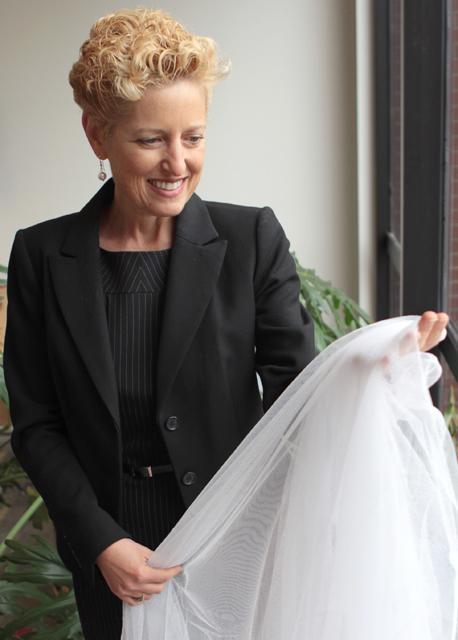
© NCSU Student Media 2012
Marian McCord, associate professor of textile engineering science, chemistry and biomedical engineering, holds a mosquito net, a textile on which she has performed extensive research. Photo by Katherine Hoke
Marian McCord , an associate professor in textiles, works in the field of the biomedical applications of textiles. Her lab on Centennial Campus uses state of the art technology, such as an atmospheric pressure plasma treatment system. From an outsider’s perspective, McCord’s work may appear to be fixed in this one specific field.
She would disagree.
“N.C . State has an enormous capacity to engage in global health,” McCord said. “We don’t have a particular department or college dedicated to global health, but our strengths map very well to global health. We’re all advancing the health of the world in general, through a multidisciplinary approach.”
McCord said the University offers specific areas of expertise within the large field, like improved food security, vaccine development, medical technology development, zoonotic disease treatment and effects climate change on health.
“We don’t need one particular institute or program to be a major contributor,” McCord said. “We bring very complementary areas of expertise to our sister institutions like Duke and UNC-Chapel Hill.”
Unlike competing programs between the institutions, McCord said in the field of global health, there must be synergy, cooperativeness and communication. She said it’s time to look past the University as an engineering school. That said, with a joint appointment within the College of Textiles and the College of Engineering’s Biomedical Engineering Department, McCord has included global health focuses on applicable programs’ senior design courses, a capstone requirement for graduation for engineering and textiles students.
But what is global health? McCord stressed the multidisciplinary aspect of the evolving field.
“Global Health is still defining itself, but it’s the promotion of human health and social development through a multifaceted approach. The challenges require this diverse approach to be solved, and will not be solved in the silo of a single discipline.”
McCord’s personal research ranges from various projects that incorporate textiles into medicine. She has developed a type of mosquito net covered with a surfactant chemical coating, which has both hydrophobic and hydrophilic properties. Mosquitoes that land on the net then go to water to spawn, but will drown because the surfactant eliminates the insects’ ability to float on water.
She is also using an atmospheric pressure plasma treatment system to treat textiles to alter their chemical properties. With the expertise and help from research assistant professor Quan Shi and graduate student Rupesh Nawalakhe , McCord is using energized gases, like helium, to enhance the absorbent properties of bandages.
The Global Health Initiatives program will launch its campus wide global health council to unite campus wide global health events next school year, including a seminar series, a professional development project and increased communication between clubs associated with the initiative’s mission.
Global health encompasses more than just medicine, according to Sunny Lin, a senior in biomedical engineering and Global Health Initiatives office assistant. Preventative or indirect measures to address a health disparity characterize the broad field. For example, the Michelson Family Foundation, which provides grants to public health projects, spoke at the University about a $25 million prize for a research team to develop a commercial, non-surgical sterilization method for dogs in cats in developing countries.
“You may not see it as a global health issue, but there are more than 50,000 a year from rabies, mostly in the developing world,” McCord said.
NCSU Global Health Initiatives is looking for students and faculty in the humanities to foster a campus-wide discussion in global health. Healthcare interventions are not feasible on an international scale without special attention to cultural norms and nuances, according to McCord .
“We can’t look inside [from the outside] and figure out what are the needs of a certain community,” McCord said. “We need to hear what are the needs from bottom of the pyramid stakeholders. I’m not interested in any project that doesn’t engage bottom of the pyramid stakeholders.”
McCord pilot tested this idea through her global health push in health related senior design courses, and two teams of senior-design students traveled with CSLEPS Alternative Service Break trips to Honduras and Guatemala. McCord traveled to the World Hunger Summit in Honduras.
Global Health Initiatives has shown success within engineering and textiles, but for McCord , the field must be more inclusive, and she encourages students interested in health from any aspect, whether it’s medicine, nutrition or water sanitation, to engage in the initiative’s events.
“I want to see this as a program in which you work in the framework of your own course of study, but you come together in a broader, periodic meeting to work with other students on this particular issue,” McCord said.